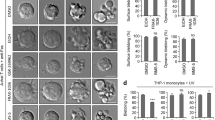Abstract
PED/PEA-15 is a recently cloned 15 kDa protein possessing a death effector domain (DED). In MCF-7 and HeLa cells, a fivefold overexpression of PED/PEA-15 blocked FasL and TNFα apoptotic effects. This effect of PED overexpression was blocked by inhibition of PKC activity. In MCF-7 and HeLa cell lysates, PED/PEA-15 co-precipitated with both FADD and FLICE. PED/PEA-15-FLICE association was inhibited by overexpression of the wild-type but not of a DED-deletion mutant of FADD. Simultaneous overexpression of PED/PEA-15 with FADD and FLICE inhibited FADD-FLICE co-precipitation by threefold. Based on cleavage of the FLICE substrate PARP, this inhibitory effect was paralleled by a threefold decline in FLICE activation in response to TNF-α. TNFα, in turn, reduces PED association with the endogenous FADD and FLICE of the cells. Thus, PED/PEA-15 is an endogenous protein inhibiting FAS and TNFR1-mediated apoptosis. At least in part, this function may involve displacement of FADD-FLICE binding through the death effector domain of PED/PEA-15.
This is a preview of subscription content, access via your institution
Access options
Subscribe to this journal
Receive 50 print issues and online access
$259.00 per year
only $5.18 per issue
Buy this article
- Purchase on Springer Link
- Instant access to full article PDF
Prices may be subject to local taxes which are calculated during checkout








Similar content being viewed by others
References
Bertin J, Armstrong RC, Ottilie S, Martin DA, Wang Y, Banks S, Wang GH, Senkevich TG, Alnemri ES, Moss B, Lenardo MJ, Tomaselli KJ and Cohen JI. . 1997 Proc. Natl. Acad. Sci. USA 94: 1172–1176.
Boldin MP, Goncharov TM, Goltsev YV and Wallach D. . 1996 Cell 85: 803–815.
Chinnaiyan AM, O'Rourke K, Tewari M and Dixit VD. . 1995a Cell 81: 505–512.
Chinnaiyan AM, Tepper CG, Seldn MF, O'Rourke K, Kischkel FC, Hellbardt S, Krammer PH, Peter ME and Dixit VM. . 1995b J. Biol. Chem. 271: 4961–4965.
Condorelli G, Vigliotta G, Iavarone C, Caruso M, Tocchetti CG, Andreozzi F, Cafieri A, Tecce MF, Formisano P, Beguinot L and Beguinot F. . 1998 EMBO J. 17: 3858–3865.
Darzynkiewicz Z, Robinson JP and Crissman HA. . 1994 In: Methods in Cell Biology Academic Press.
Dudek H, Datta SR, Franke TF, Birnbaum MJ, Yao R, Cooper GM, Segal RA, Kaplan DR and Greenberg ME. . 1997 Science 275: 661–665.
Han AKM, Chaudhary PM, Wright ME, Friedman C, Trask BJ, Riedel RT, Baskin DG, Schwart SM and Hood L. . 1997 Proc. Natl. Acad. Sci. USA 94: 11333–11338.
Henderson S, Huen D, Rowe D, Dawson C, Johnson G and Rickinson A. . 1993 Proc. Natl. Acad. Sci. USA 90: 8479–8483.
Henkart PA. . 1996 Immunity 4: 195–201.
Hu S, Vincenz C, Ni J, Gentz R and Dixit VM. . 1997 J. Biol. Chem. 272: 17255–17257.
Irmler M, Thome M, Hahne M, Scheider P, Hofmann K, Steiner V, Bodmer JL, Schroter M, Burns K, Mattmann C, Rimoldi D, French LE and Tschopp J. . 1997 Nature 388: 190–195.
Itoh N, Yonehara S, Ishii A, Yonehara M, Mizushima S, Sameshima M, Hase A, Seto Y and Nagata S. . 1991 Cell 66: 233–243.
Kischkel FC, Hellbardt S, Berhmann I, Germer M, Pawlita M, Krammer PH and Peter ME. . 1995 EMBO J. 14: 5579–5588.
Medema J, Scaffidi C, Kischkel FC, Shevchenko A, Mann M, Krammer PH and Peter ME. . 1997 EMBO J. 16: 2794–2804.
Muzio M, Chinnaiyan AM, Kischkel FC, O'Rourke K, Shevchenko A, Ni J, Scaffidi C, Bretz JD, Zhang M, Gentz R, Mann M, Krammer PH, Peter ME and Dixit VM. . 1996 Cell 85: 817–827.
Nagata S and Suda T. . 1995 Immunol. Today 16: 39–42.
Nagata S and Golstein P. . 1995 Science 267: 1449–1456.
Sambrook J, Fritsch EF and Maniatis T. . 1989 In: Molecular Cloning: A Laboratory Manual, 2nd Edn Cold Spring Harbor Laboratory: Cold Spring Harbor, New York.
Shen Y and Shenk TE. . 1995 Curr. Opin. Genet. Dev. 5: 105–111.
Srinivasula SM, et al. 1997 J. Biol. Chem. 272: 18542–18545.
Srinivasula SM, Ahmad M, Fernandes-Alnemri T, Litwack G and Alnemri ES. . 1996 Proc. Natl. Acad. Sci. USA 93: 14486–14491.
Thome M, Schneider P, Hofmann K, Fickenscher H, Meinl E, Neipel F, Mattmann C, Burns K, Bodmer JL, Schroter M, Scaffidi C, Krammer PH, Peter ME and Tschopp J. . 1997 Nature 386: 517–521.
Thompson CB. . 1995 Science 267: 1456–1462.
Acknowledgements
The authors are grateful to Drs E Consiglio and G Vecchio for their continuous advice during the course of this work, and to GL Condorelli (Jefferson Medical College, Philadelphia) for technical advice and helpful discussion. We would also like to thank Drs B Trimarco for support, M Vitale for flow-cytometric quantitation of apoptosis, C Garbi for help with fluorescence microscopy, D Liguoro for the technical help and L Beguinot (DIBIT, HS Raffaele, Milan) for critical reading and discussion of the manuscript. This work was supported in part by the Biomed2 program of the European Community (Grant BMH4-CT-0751 to F Beguinot), a Telethon grant (Grant E.554) to F Beguinot, grants from the Associazione Italiana per la Ricerca sul Cancro (AIRC) to F Beguinot and P Formisano, the Ministero dell’ Università e della Ricerca Scientifica, the CNR Target Project on Biotechnology and the Lilly and Novartis pharmaceuticals. M Caruso and G Vigliotta are recipients of fellowships of the Federazione Italiana per la Ricerca sul Cancro (FIRC). Almerinda Cafieri is the recipient of an award by Telethon Italy.
Author information
Authors and Affiliations
Rights and permissions
About this article
Cite this article
Condorelli, G., Vigliotta, G., Cafieri, A. et al. PED/PEA-15: an anti-apoptotic molecule that regulates FAS/TNFR1-induced apoptosis. Oncogene 18, 4409–4415 (1999). https://doi.org/10.1038/sj.onc.1202831
Received:
Revised:
Accepted:
Published:
Issue Date:
DOI: https://doi.org/10.1038/sj.onc.1202831
Keywords
This article is cited by
-
Integrin α5β1 and p53 convergent pathways in the control of anti-apoptotic proteins PEA-15 and survivin in high-grade glioma
Cell Death & Differentiation (2016)
-
Quantitative proteomics for identifying biomarkers for Rabies
Clinical Proteomics (2013)
-
Targeting microRNAs to modulate TRAIL-induced apoptosis of cancer cells
Cancer Gene Therapy (2013)



